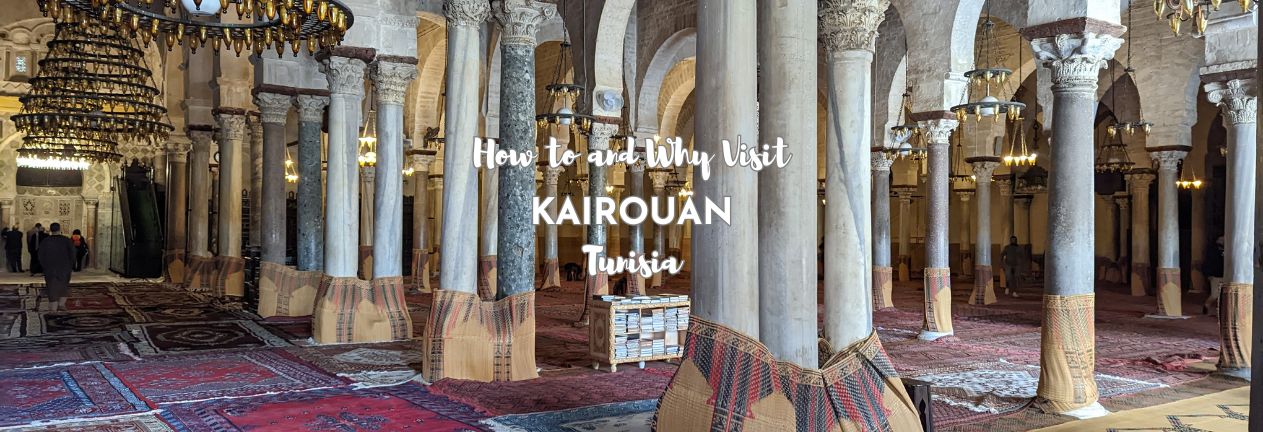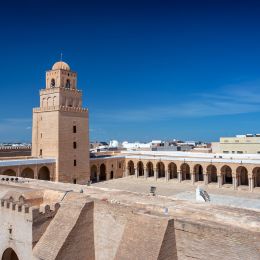At just 65 kilometers (40 miles) from Sousse and en route to the magnificent El Jem, it’s hard to turn down the opportunity to visit Kairouan. This is Tunisia’s holiest city and, according to the Islamic faith, the fourth most holy city after Mecca, Medina, and Jerusalem. The city is also home to numerous historical sites, many of which are associated with its inclusion on the UNESCO World Heritage list. Here’s our guide on how to visit Kairouan and what to see here.
THIS POST MAY CONTAIN COMPENSATED AND AFFILIATE LINKS MORE INFORMATION IN OUR DISCLAIMER
While it’s relatively easy to visit Kairouan using public transport, which I’ll detail shortly, it’s also just as easy to tag it onto a day trip to the stunning El Jem, and it’s a worthwhile addition. I mean, it’s hard to turn down UNESCO sites, stunning carpets (yes, really, Kairouan is famous for carpets), and another medina and more souks to explore, right? Kairouan was also the capital of Tunisia from 800 AD to 909 AD.
EASIEST WAY TO VISIT
Take an EASY Day Trip to Kairouan
Visit from Sousse, Monastir, Hammamet or even Tunis. Get air conditioned comfort between all of Kairouan’s sites, and a local guide to make sure you don’t miss anything.
Why Visit Kairouan
You’ll come for the UNESCO World Heritage contribution that this original capital city of Tunisia now holds. Or perhaps the historic Islamic faith connections that this, the fourth most holy city in Islam, contains. Perhaps it’s carpets, as the city is the most important in the production of carpets in Tunisia. Or maybe it’s the Makroudh, the sweet treat that the city is famous for.
Where is Kairouan?
The city of Kairouan is located in the province of the same name and is 40 miles (60 kilometers) west of Sousse, and about 2 hours south of Tunisia’s capital city of Tunis. It’s not on the coast, it’s not in the mountains, although it is on major bus routes (we passed through it on our return from Tozeur (read about that here!)
PRACTICAL TRAVEL TIPS
- 🛡️ Get Travel Insurance: Civitatis includes medical expenses, repatriation, theft, luggage delays. No deductibles or upfront payments. Get a quote here.
- 💰 Read about the Currency in Tunisia and ATM fees.
- 🔌 Check out Tunisia’s plug, socket & power situation.
- 📶 Internet, maps and data on the go. eSims for Tunisia
How to Get to Kairouan
Most people will visit Kairouan from Sousse, although you can also take a louage from Tunis too. There’s no train station here, so you’re limited to either using a louage, a bus, or taking a trip. And to be honest, if you’re already taking a day trip to El Jem,(my guide is here) then this is a great addition for your day out. It is the perfect day trip from Sousse.
Taking a tour of Kairouan
Virtually all trips to El Jem, whether they’re from Sousse, Monastir, Hammamet, or Tunis, make a stop at Kairouan. Here are the best options
Louages from Tunis to Kairouan
Louages for Kairouan depart from Station Louage Moncef Bey in Tunis, take about 2 hours, and cost around 15 TND. The louage station in Kairouan is located in the north west of the city, about a 26-minute walk from the Grand Mosque in the city. There’s more on louages and how they work as well as other forms of transport in Tunisia in my guide here.
You’ll need cash for louages, so read my guide to cash, payments and ATMs in Tunisia here.
Louages from Sousse to Kairouan
Tunisia’s shared minibuses are the best way to get to Kairouan on public transport. Louages from Sousse cost around 6 TND each way. You’ll need to get to the Al Lawajat Station in Sousse to get your trip started.
What to see in Kairouan
The main attractions in Kairouan are in an almost circular loop, so you shouldn’t have to backtrack on yourself if you’re traveling independently and not taking a tour. You’ll want to get an early start, so that the louages go frequently and so that you have enough time to travel between the sites. (These tours will transport you between the main sites, so you don’t have to worry about the timings.)
I’ll take you through the things to see in Kairouan in a clockwise route from the louage station.
The Zaouia of Sidi Sahabi
There are a variety of reasons that Kairouan is considered so holy, and that’s because it’s the final resting place of a close friend and barber to the Prophet Mohammed, Abu Zama’a al-Balawi was also known as Sidi Sahib. The Zaouia of Sidi Sahabi is just a two-minute walk from the louage station, which makes it perfect as your first or last stop in Kairouan.
This is both a mausoleum for the barber and a mosque. It’s covered on the Kairouan ticket, which you can buy at each of the included sites, although tickets aren’t always checked. The main attraction here is the hallways lined with stunning tiles. They lead you to an inner courtyard, decorated with stunning carved designs and more tiles.
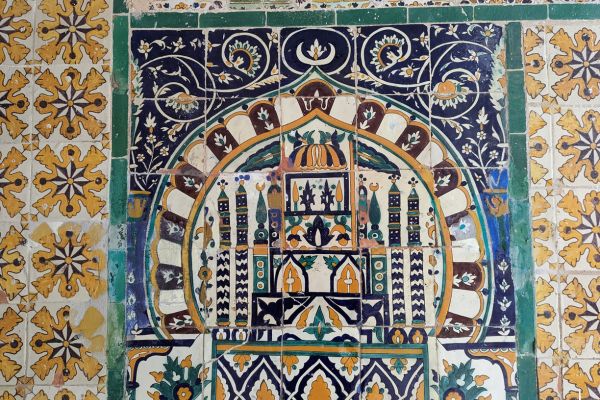
Abu Zama al-Balawi was killed in battle in 654CE, and his body was brought here to be buried. It’s believed that he wore an amulet containing hairs from the beard of the Prophet, who had died in 632CE.
The Basins of the Aghlabid
If you’re taking a tour to Kairouan and El Jem, then this will be your first stop. It’s also the site of the Kairouan Tourist Information Office, which will sell you a ticket to the Kairouan sites that I mentioned above. The ticket includes all the sites listed below, but you can pay for entrance to individual sites. The main thing that you need to know about the Tourist Information Office is that they have clean toilets and that the roof above it is where you can get a great view of the Aghlabid Basins.
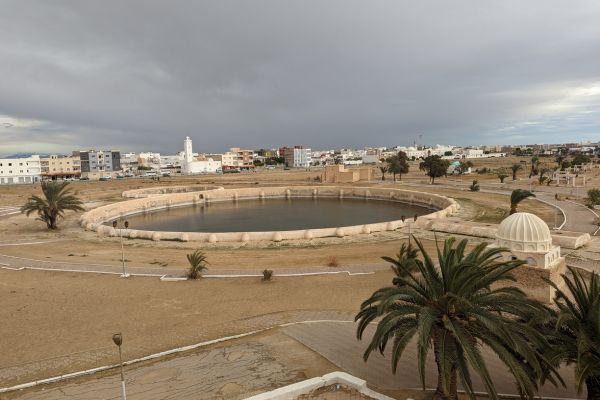
The basins date from the 9th century and are actually a complex of (originally) 16, but now only two cisterns that were built to provide water for Kairouan. They’re called the Aghlabid basins as they were built during the Aghlabid Dynasty. They might not look much today, but they’re a stunning piece of building, especially when you consider the date that they were designed and built.
The connected cisterns formed an open-air reservoir that’s fed by a 58-kilometer (36-mile) aqueduct that brings water from the Shreshira (or Chrechira) Mountains to the west of the city. The ponds or basins act as a settling tank and filter the water. Originally, the water flowed into a smaller pool, which then filtered out sediments before the water was transferred to the large pond or basin. The large basin is 4.8 meters (16 feet) deep and 128 meters (420 feet) in diameter. While the pools look like their circular, they’re actually 17-sided polygons.
The Grand Mosque of Kairouan, aka Mosque Okba
This is the main attraction here in Kairouan. You’ll need your ticket to get in here. The Great Mosque of Kairouan, or Mosque Okba, is the main tourist attraction in town. As a woman, you’ll need to cover your arms and head. If you don’t travel with a scarf, then you can borrow a headscarf at the entrance.
The Grand Mosque, or the Great Mosque, was built in 670 CE by Uqba Ibn Nafi, who founded Kairouan. North Africa during this time wasn’t a particularly stable place, and the mosque had to be rebuilt several times, with the mudbrick structures being torn down and replaced in 836 by a stone, brick, and wood construction by Prince Ziyadat Allah I. The prayer hall here is supported by rows of columns, and there is an open courtyard.
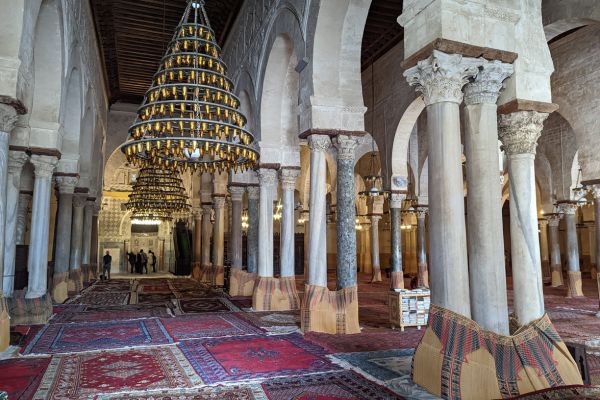
The courtyard entrance and a dome over the central arches were added in the 9th century. The dome is made of stone with 24 ribs. The minaret also dates from the ninth century and seems to have been inspired by Roman lighthouses, its 32 meters (105 feet) tall.
It was the Hafsids in the 13th century that added the fortified look to the mosque, adding buttresses that were really designed just to support the exterior walls, which were failing. Additional portals and gates were added, and carved stone panels inside the mosque gave details of who had paid for and designed the restorations and additions.
Only Muslims can enter the prayer hall, but you can look in from the courtyard and take photos (but not during prayers). It’s a stunning site. 600 marble columns contribute to the construction of the mosque.
The Mosque of the Three Doors, aka Djemaa Tleta Bibane
This mosque, which can only be entered by Muslims, is one of the earliest examples of Islamic architecture that has a carved façade. It was originally built in the 9th century by Mohammed Bin Kairoun El Maafri, originally hailing from Cordoba, Spain. The friezes above the three doors are Kufic script and floral designs, reminiscent of Andalusian influence.

The House of the Governor
Once the home of the governor of Kairouan, this building is now both privately owned and operating as a carpet shop. Kairouan is famed, not just for the Great Mosque, but also carpets. Bear in mind that while you come in, you can watch artisans making the carpets, but you can expect a pretty strong sales pitch.
The Mausoleum of Sidi Abid el Ghariani
This mosque was begun by Al-Jadidi in the 14th Century, but as he died on pilgrimage to Mecca in 1384 CE, building work was halted. It didn’t complete until Abu Samir Abid el Ghariani, his disciple, took it over. The mosque’s namesake, who died in 1402, is buried inside the mosque.
The Jalladin Gate, aka the Leather Workers Gate
The Kairouan medina is surrounded by massive walls that stretch for 3 kilometers (1.86 miles) around it. Entrance historically has always been through the gates, and in Kairouan, there are four. Bab Tunis, Bab al-Khukha, Bab al-Khukha (Gate of the Hatch/Counter), Bab al-Jalladin (Gate of the Leather Workers), and Bab al-Shuhada’ (Gate of the Martyrs).
This gate is also known as the Indiana Jones Gate, as scenes from Raiders of the Lost Ark were filmed near the Jalladin Gate, when Kairouan was masquerading as Cairo. A section of the wall, near this gate, collapsed in December 2023, killing three people, following a period of heavy rain.
Bir Barrouta
Bir means “well” as in a source of water, and “routa” was the name of a dog owned by one of the Prophet’s companions. Legend has it that it was this dog that discovered the well here, and it led to the formation of the city of Kairouan. The well was built in 796, restored in 1690, and is 20 meters (65 feet) deep.
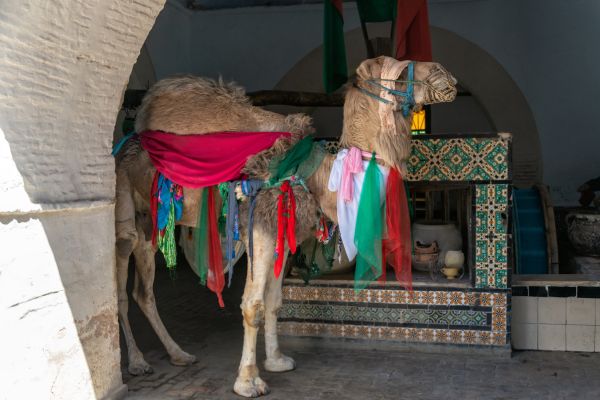
The water had to be drawn from the deep well, and originally, it was a camel, walking in circles, that was “pulley system” to get the water from the ground. The camel is no longer needed; there’s running water and electricity, but it’s retained as a tourist attraction.
Get lost in Kairouan’s Medina.
Kairouan’s Medina is worth a wander; it’s not as intense as the one in Tunis, nor, I think, as relaxed as the one in Monastir. It’s surrounded by two sets of 7-kilometer (4.34-mile) long walls. It’s quiet, atmospheric, and worth wandering around.
Shop in Kairouan’s Souk
Close to Bir Barrouta is the souk, where the main attraction is carpets. But of course, you can buy everything else too.
Head to Makroudh Rqaya for a sweet treat
Kairouan’s contribution to cuisine comes in the form of Makroudh. It’s a date-filled pastry that’s been soaked in honey.
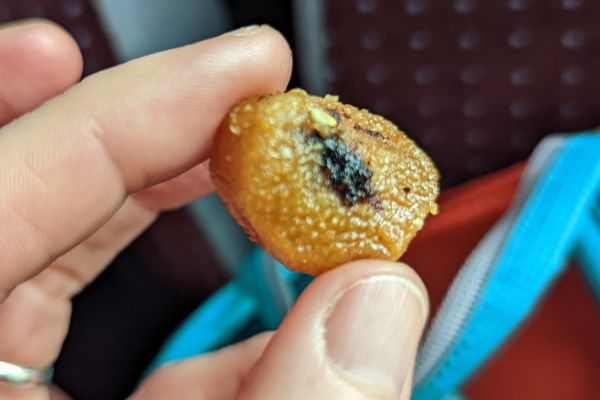
The best place to buy and try? That’s at Makroudh Rqaya, very close to the Aglabides Basins. If you miss that, then there are other bakeries within the medina.
TUNISIA TRAVEL RESOURCES
AIRPORT TRANSFERS
24/7 pickup & drop off. Trusted, local English speaking drivers. Prebook & prepay online with cards.
Book a Transfer
HOTELS AND APARTMENTS
See choices here
Sea view rooms? Budget rooms? Need a washing machine? The best choice of hotels & apartments.
TOURS & ATTRACTIONS
Most excursion choices, small group tours, skip-line tickets, free cancellation and top local guides.
Top options here.
CAR RENTAL OPTIONS
Choose cars here
Best choice of vehicles, automatics, large or small cars, child seats. Book early for more options.
Final Words on How to Visit Kairouan
Whether you visit on a day trip or travel here independently, this is an important city in Tunisia and for the Islamic faith. It doesn’t feel particularly touristy; most people are going about their business here, and the medina is all the better for it. There are some interesting UNESCO World Heritage sites here to explore, and the history is undeniable.
ASocialNomad is a participant in the Amazon Services LLC Associates Program, an affiliate advertising program designed to provide a means for sites to earn advertising fees by advertising and linking to amazon.com, amazon.co.uk, and amazon.ca. Amazon and the Amazon logo are trademarks of Amazon.com, Inc. or its affiliates. As an Amazon Associate, I earn from qualifying purchases.
